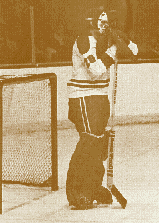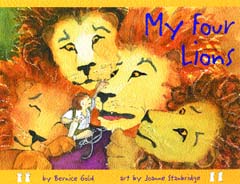Good company
 What
do Plato, former president George Bush and McGill grad Ken Dryden
have in common? They're among the first 20 inductees into an
unusual club - the International Scholar-Athlete Hall of Fame.
Plato? He made the cut for having promoted the ideal of combining
philosophical training for the mind with physical training for
the body. What
do Plato, former president George Bush and McGill grad Ken Dryden
have in common? They're among the first 20 inductees into an
unusual club - the International Scholar-Athlete Hall of Fame.
Plato? He made the cut for having promoted the ideal of combining
philosophical training for the mind with physical training for
the body.
Dryden, LLB'73, maintained both an impressive GPA and GAA (goals
against average) as a law student moonlighting in nets for the
Montreal Canadiens hockey team. He made his debut in the 1971
playoffs and coolly handled the likes of Bruins stars Orr, Esposito
and Bucyk, eventually leading the Habs to the Stanley Cup.
But perhaps more than any of his dazzling saves, it may be
Dryden's "thinker's pose" that people remember most vividly.
While play was at the other end of the ice, Dryden stood with
arms crossed over his stick and appeared utterly relaxed. He
retired from the Canadiens in 1979 to practice law, and in 1997
was named president of the Toronto Maple Leafs.
Another McGill grad, James Naismith, BA1887, credited with
inventing the game of basketball while teaching school in Massachusetts,
was also among the honorees, along with Frenchman Pierre de
Coubertin, founder of the modern Olympics, and Dr. Roger Bannister,
a British neurologist who broke the four-minute mile.
|
Biscuits for Bowser
|
|
Cindie Horst, BA'93, never dreamed that
a sick dog would bring her international success. When Cody, her border collie/blue heeler mix, was diagnosed
with a serious blood disorder and placed on a strict drug regimen,
she began looking for nutritious treats for her ailing pooch.
Finding nothing suitable, she decided to bake her own biscuits.
She regularly packed up little bags of leftovers for friends'
dogs who became as fond of them as Cody. "Then I began to think
'what if...,'" says Cindie. "I did research into what people
spend money on and I discovered that pets are often the most
pampered members of the family." So in 1997 she opened the Growlin'
Gourmet, a health food bakery for dogs, and found she was definitely
barking up the right tree. Last year, her business was nominated
for the Achievement in new Retail Concept award given annually
by Cadillac Fairview. Though she didn't win the $50,000 prize,
the resulting publicity was priceless.
 Because
her shop is in the tourist town of Stratford, Ontario, Cindie
now has a lot of international customers. They drop in, take
goodies home to Britain, Germany or Japan, then keep mailing
for more. Ever the savvy marketer, Cindie regularly consults
a canine focus group. "We have all varieties and sizes of dogs.
We just line up the biscuits and see what they go for first."
The big seller is P-Mutt Butter, with Yappy Apple a close second.
For the trendy hound there's Bow-Wow Biscotti, while the more
traditional types might prefer Mailman Fingers. Cindie says
she consumes her fair share of doggie treats. "We're always
snacking on them in the back room. They're good for people,
too, but you need a big glass of water handy - they are a bit
dry." Because
her shop is in the tourist town of Stratford, Ontario, Cindie
now has a lot of international customers. They drop in, take
goodies home to Britain, Germany or Japan, then keep mailing
for more. Ever the savvy marketer, Cindie regularly consults
a canine focus group. "We have all varieties and sizes of dogs.
We just line up the biscuits and see what they go for first."
The big seller is P-Mutt Butter, with Yappy Apple a close second.
For the trendy hound there's Bow-Wow Biscotti, while the more
traditional types might prefer Mailman Fingers. Cindie says
she consumes her fair share of doggie treats. "We're always
snacking on them in the back room. They're good for people,
too, but you need a big glass of water handy - they are a bit
dry."
|
A roaring success

Bernice Gold, BA'43, and Joanne Stanbridge, MLIS'88, did all
the wrong things according to the rules of book publishing,
but it came out just right. The two met at a group for authors
of children's books, where Gold read a story she had written
about a boy and some imaginary lions who quiet his fears about
being home alone. A publisher was already interested. The reading
inspired the artist in Stanbridge, a librarian by profession,
who later contacted Bernice and shyly asked if she could show
her "a few illustrations."
"I had no idea Joanne was also a painter, but I loved her work
from the moment I saw it," says Gold. So did the publisher,
and a collaboration was born. Unfortunately, after months of
work, the publishing company went broke. Undeterred, the pair
pressed on, despite warnings that children's books are invariably
rejected when submitted as a finished package. "We just thought
'Nuts, we'll take the chance,'" says Gold. "We enjoyed the process
so much, we decided neither of us really minded if we failed
to find another publisher."
Against the odds, the book dummy they produced was snapped
up and Annick Press has just released My Four Lions. Stanbridge,
already a published author, is thrilled at branching out into
illustration. "I came to this pretty late. I took some painting
courses and it quickly became a passionate hobby. The whole
experience of putting this book together has been sort of magical
- just like a work of fiction."
|
Kayaking the country
What did you do on your summer vacation? Chances are it wasn't
kayaking across three quarters of Canada. That's exactly what
21-year-old wildlife biology graduate Ilya Klvana is doing on
his Kayak Canada 99 Expedition to raise awareness of the threats
to the country's waterways, which he says are "all too often
dammed, polluted, mismanaged and destroyed."
Klvana's self-proclaimed "crazy kayak trip" began in Prince
Rupert, B.C., in May and he is still paddling, planning to end
the 7,380-kilometre journey in Montreal in late October. Travelling
along routes used by early fur traders in a 16.5 foot kayak
he built himself, Klvana has had to contend with a multitude
of hazards: merciless winds, tidal and arctic currents, landslides,
grueling portages, forest fires, hailstorms, charging moose,
angry bears - even incontinent bald eagles. In other words,
he's having a great time. He has also seen some of the country's
most beautiful sights, from wolves on the waterbanks to the
rugged charm of the many-channeled Churchill River, and met
scores of kind people who have let him camp on their land or
invited him into their homes for a hot meal and a break from
sleeping in a tent.
When he finishes, Klvana will be the first person to have crossed
Canada by kayak from the Pacific Ocean to Montreal in one season.
McGill is hosting a website documenting his trip, replete with
maps, photos, and fascinating journal entries e-mailed by Klvana
via satellite. You can follow the expedition and send him a
message of encouragement at ww2.mcgill.ca/kayak/.
|
Mastering the non-profit sector
 The
name McConnell is a familiar one around McGill, attached as
it is to a residence, an arena and an engineering building.
Benefactor John W. McConnell, a Montreal businessman who served
on the Board of Governors for 30 years (1928-58), also bought
and donated to McGill the homes which became Purvis Hall and
Chancellor Day Hall, as well as the first Presbyterian College,
now Morrice Hall. After his death in 1963, McConnell's family
expanded his support of local charitable and educational institutions,
eventually funding community development projects throughout
Canada. The
name McConnell is a familiar one around McGill, attached as
it is to a residence, an arena and an engineering building.
Benefactor John W. McConnell, a Montreal businessman who served
on the Board of Governors for 30 years (1928-58), also bought
and donated to McGill the homes which became Purvis Hall and
Chancellor Day Hall, as well as the first Presbyterian College,
now Morrice Hall. After his death in 1963, McConnell's family
expanded his support of local charitable and educational institutions,
eventually funding community development projects throughout
Canada.
The J.W. McConnell Family Foundation is now a partner with
McGill's Faculty of Management in offering a unique graduate
program aimed at enhancing the effectiveness of voluntary organizations
by training their leaders. With governments taking resources
out of community services, volunteers are having to be more
active in areas like social justice, the arts, health care and
the environment. Dr. Frances Westley, executive director of
the new Master of Management for National Voluntary Sector Leaders,
told the National Post that "more and more of the responsibility
for a compassionate, healthy or sustainable society is in the
hands of this sector."
Students in the 18-month, $33,000 program - the first of its
kind in North America - must be full-time, senior employees
of national non-profit organizations. The employer pays a quarter
of the cost while the Foundation picks up the rest. Faculty
members are drawn from universities across the country and "class"
time is broken up into five one- or two-week modules, including
one in Australia and India. Students return to their jobs between
modules to complete field projects, collaborative ventures and
papers aimed at linking what they're learning to the working
life of their organizations.
Wallace Crowston, Dean of the Faculty of Management, was sold
on the idea from the start and says the innovative program provides
a "marvellous opportunity for two widely recognized institutions
to work together." Adds Crowston, "From the day the Foundation
approached us, we were convinced that we could make a worthwhile
contribution to the non-profit sector through this partnership."
|
|











